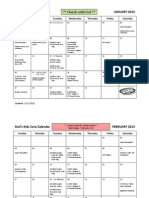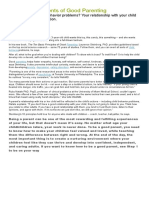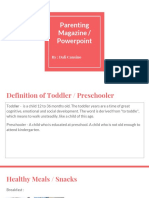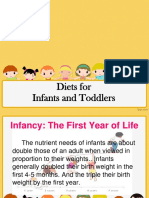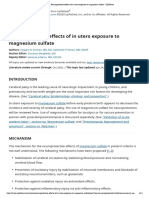Baby Food Charts
Baby Food Charts
Uploaded by
Anji EmmadiCopyright:
Available Formats
Baby Food Charts
Baby Food Charts
Uploaded by
Anji EmmadiCopyright
Available Formats
Share this document
Did you find this document useful?
Is this content inappropriate?
Copyright:
Available Formats
Baby Food Charts
Baby Food Charts
Uploaded by
Anji EmmadiCopyright:
Available Formats
Baby Food Charts | Baby Food
Page 1 of 10
Submit Query
Baby Food Chart
l l
Home Baby Food Charts
Pampers New Born Diaper
Learn More About your New Baby Development. Get Helpful Advice. www.in.pampers.com
Baby 4-6 Months
Find accurate and free articles by leading doctors IndianWomensHealth.com
Baby Food Charts
Posted by admin on February 22nd, 2010
Pampers Baby Diapers Make Your Baby Comfortable. Pick the Right Diaper for your New Born.
www.in.pampers.com
Gifts for Pregnant women Expecting a baby? Get a free Gift Voucher!
lifecellinternational.com/babyoye
Food Chart for Newborn Infant
Breast Milk Newborn should feed on cue about 8-12 times per day until satisfied. They will usually breastfeed for 10-15 minutes per breast at each feeding. The feeding time typically decreases as the baby gets older and learns to feed more efficiently. If a newborn infant, in the first few weeks of life, is not demanding to be fed at least every 4 hours, he
http://www.babyfoodchart.com/baby-food-charts/
5/30/2011
Baby Food Charts | Baby Food
Page 2 of 10
should be awakened to feed. Crying is a late sign that an infant is hungry. Other signs or cue that an infant is ready to feed include:
l l l l l l
fussiness agitation tongue movement lip movement fists in mouth opening his mouth when the skin around his mouth, cheeks or lips is touched
Babies between the ages of 1 to 4 months will be feed less frequently than newborns. They usually feed 6-8 times a day (or every 3-4 hours). They may also begin to sleep through the night without feeding. How Much Breast Milk is Enough? It is impossible for mothers to know exactly how much a newborn is drinking during a breastfeeding session. The best way to know if a newborn infant is receiving enough breast milk is:
l l
by counting the number of wet diapers produced in a day. by measuring the weight gain.
A newborn infant may only have 3 wet diapers in a day during the first days of life. Wet diapers should increase in frequency and volume each day. After the first week, he should have 6-8 wet diapers a day. Infants between the ages of 1 to 4 should produce 6 or more heavy, soaked diapers per day. Weigh gain is a good indicator that an infant is getting enough nutrition from breastfeeding. Infant Formula For parent choose not to breastfeed, formula is the most acceptable alternative. There are many different types of formula available in the marketplace. They are different according to the food source on which they are based. They are described below. Cows milk based formulas: Cows milk based formulas are one of the most common types of infant formula on the market. These formulas come in both low-iron type and iron-fortified varieties. Most health authorities recommend using iron-fortified formula for infants who will be consuming formula exclusively until they are 9-12 months old. Example:
l l
Enfamil with Iron, Similac
Infant formulas with Omega 3 and Omega 6 fatty acids These formulas come in cows-milk-based and soy-based varieties. They have added DHA (docosahexanoic acid) and ARA (arachidonic acid). These two fatty acids, which support normal brain, eye, and nerve development, can also be found in breast milk. There is a lack of evidence at this time to
http://www.babyfoodchart.com/baby-food-charts/
5/30/2011
Baby Food Charts | Baby Food
Page 3 of 10
support the claim that healthy children will have better visual acuity or mental test scores because they consumed formulas with DHA and ARA. Example:
l l l l
Enfamil A+, Similac Advance, Good Start with Omega 3 and Omega 6, Isomil with Omega 3 and 6
Soy-based Formulas You can choose soy-based formula if your infant suffers from milk protein allergy. However, soy-based formula may not be tolerated by children with non-IgE medicated cows milk intolerance. Yu need to speak to your doctor about what type of cows milk allergy your child may have. Soy-based formulas are not recommended as the first choice for healthy term infants who are not being breastfed. However it is recommended by America Academy of Pediatrics as save alternatives to breast milk or cows-milk-based formulas to provide appropriate nutrition for normal growth and development. Example:
l l l
Enfamil Soy, Isomil Alsoy
Protein Hydrolysate Formulas, casein-based This is a hypoallergenic formula. It is a better choice for non-breastfed infants with cows milk protein allergy. The protein of this type of formula is broken into very small units called peptides and free amino acids. This type of formula is very expensive. Example:
l
Nutramigen
Protein Hydrolysate Formulas, whey-based This type of formula contains larger. Because of that, it is not appropriate for children with a confirmed allergy to cows milk protein. The taste of this formula is similar to cows-milk-based formula. The cost is not as expensive as casein-based protein hydrolysate formulas. Example:
l l
Nestle Good Start Enfamil Gentlease A+
Lactose-free Formulas Lactose-free formulas are based on cows milk. The lactose is removed. It is then added with corn syrup
http://www.babyfoodchart.com/baby-food-charts/
5/30/2011
Baby Food Charts | Baby Food
Page 4 of 10
solids. This formula is for infant who suffer from primary lactose intolerance. It is can be used as an alternative for infants who develop secondary lactose intolerance. Example:
l l
Enfamil Lactose Free Similac Sensitive Lactose Free
Follow-up Formulas This type of formula can be based on cows milk or soy. Follow-up formulas are iron-fortified. They are better choice than whole cows milk for older infants between ages of 6 to 12 months. They contain lower renal solute load than wholes cow milk and are therefore easier on a babys kidney. It is proven that follow-up formulas offer more benefits than traditional infant formulas. Parents can comfortably use the same starter formula from birth until 12 months of age. Example:
l l l
Nestle Follow-up Nestle Follow-up Soy Enfapro A+
Added-rice Formulas Added-rice formulas combine rice starch and a conventional cows milk based formula. This formula is for healthy infant who occasionally spit up as the added starch is intended to help the formula settled in the childs stomach. If your child spit up persistently, you should seek advice from a physician or a pediatrician. Example:
l
Enfamil Thickened A+ for babies who spit up
Specialty Formulas Specialty Formulas are for those infants have difficulty in digesting or absorbing carbohydrates, protein, fat and other nutrients. Generally these formulas are used under the supervision of a doctor or a dietician. Example:
l l l
Alimentum Neocate Infant Pregestimil
How Much Formula is Enough? The formula consumed by an infant will increase with age. It will also vary depending on infants size and activity level. The following table shows an example of estimated intake:
http://www.babyfoodchart.com/baby-food-charts/
5/30/2011
Baby Food Charts | Baby Food
Page 5 of 10
Age
Feeds / Day
Quantity / Feed (estimated) 2 to 3 oz / 60 to 90 ml 3 to 4 oz / 90 to 120 ml 4 to 6 oz / 120 to 180 ml 6 to 7 oz / 180 to 210 ml 7 to 8 oz / 210 to 240 m
Birth to 1 week 1 week to 1 month 1 3 months 3 7 months 7 12 months
6 to 10 6 to 8 5 to 6 4 to 5 3 to 4
Food Chart for 6 to 8 Months
It is recommended to delay the introduction of solids until the infant is about 6 months old. Infant at the age of 6 months has digestive tract that is mature enough to digest complex proteins, fats and carbohydrates. They are also able to sit and to swallow non-liquid foods. However it is important to remember that solids must be introduced gradually. During the initial transition period, breast milk or formula will continue to be an infants primary source of nutrients. Table below acts as a guideline on how much foods you can offer to your child. Every baby is different. So you should make necessary adjustment according to your kids need. Foods Breast Milk Formula Iron-fortified singleingredient food Other grain product Meat and alternative 6 to 9 Months Nursing on demand Bottle feed on demand (about 3-5 feeds per day) Twice daily of iron-fortified infant cereal, 2 to 4 tablespoons / 25 to 60 ml per serving Dry toast or unsalted crackers Mash or strained meat Fish Poultry Mashed silken tofu Well-cooked legumes (beans, lentil, chickpeas) Eggs yolks Pureed or mashed cooked vegetables of all colors. Progress to soft mashed consistency. 4 to 6 tablespoons / 60 to 90 ml per day Pureed or mashed cooked fruits
Vegetables
Fruits
http://www.babyfoodchart.com/baby-food-charts/
5/30/2011
Baby Food Charts | Baby Food
Page 6 of 10
Very ripe mashed fruits such as banana or avocado 6 to 7 tablespoons / 90 to 105 ml per day Plain yogurt Cottage cheese or grated hard cheese 1 to 2 tablespoons / 15 to 30 ml per day Thickened cereal Finely mashed Soft solids Avoid honey, added sugar and salt
Milk products
Texture
Advice
Food Chart for 9 to 12 Months
Foods Breast Milk Formula 6 to 9 Months Nursing on demand Bottle feed of formula or whole cow milk 3-4 feeds per day A variety of infant cereal Plain cereals Bread Rice Pasta 8 to 10 tablespoons / 120 to 150 ml per day Minced or diced cooked meat, fish, chicken, tofu, beans or egg yolk. 3 to 4 tablespoons / 45 to 60 ml per day Minced or diced cooked vegetables. 6 to 10 tablespoons / 90 to 150 ml per day Soft peeled and diced fresh or canned fruit 7 to 10 tablespoons / 105 to 150 ml per day Plain yogurt
Iron-fortified singleingredient food Other grain product
Meat and alternative
Vegetables
Fruits
Milk products
http://www.babyfoodchart.com/baby-food-charts/
5/30/2011
Baby Food Charts | Baby Food
Page 7 of 10
Cottage cheese or grated hard cheese 2 to 4 tablespoons / 25 to 60 ml per day Soft minced foods Diced foods Avoid honey, added sugar and salt
Texture
Advice
Food Chart for 12 to 24 Months
For child after the age of 1 year, you can usually switch from infant formula to whole milk. For those with poor weight gain, infant formula may still be needed. Please ask advice from a doctor or pediatrician on when to start whole (cows) milk. As your child ability to chew and swallow improves, he can manage a greater range of foods. Fruits: You can now give your child fruit in larger pieces. However softer varieties of fruits such as banana, peaches, pears and mangos are recommended. It is necessary to cut the fruits such as grapes or berries into smaller pieces because the whole fruit could possibly lodge in a small airway. Vegetables: Vegetables should be cooked until soft. Hard vegetables such as raw carrot should be served grated. Meats: As your child gets older, they are able to chew solid foods such as meats more easily. You can allow your child to sample of what the family is having.
Subscribe via Email
l
Receive more baby food tips to your email inbox. Enter your email address here:
Subscribe Now
Delivered by FeedBurner
http://www.babyfoodchart.com/baby-food-charts/
5/30/2011
Baby Food Charts | Baby Food
Page 8 of 10
Baby 4-6 Months Find accurate and free articles by leading doctors
IndianWomensHealth.com
Pampers Baby Diapers Make Your Baby Comfortable. Pick the Right Diaper for your New Born.
www.in.pampers.com
Gifts for Pregnant women Expecting a baby? Get a free Gift Voucher!
lifecellinternational.com/babyoye
Popular Posts
l l l l l l l l l l l l l l l l l l l l
Vitamin B6 Expected Pregnancy Symptoms Week By Week When Childbirth Classes are Necessary Tips for Choosing a Great Name Probiotics in Infant Formula Dealing with Postpartum Depression The Basics of Breast Milk Breast Milk - Benefits for Baby The Health Benefits of Breastfeeding to Both Mother and Child Potential Issues with Breastfeeding and Their Solutions Supplies for Breastfeeding Breastfeeding Positions Nutrition Needs for Mom during Breastfeeding Breast Milk Express Breastfeeding Basics Choosing and Preparing Infant Formula Form of Infant Formula Nutrient Composition of Formula How Much Formula is Enough? Introducing Solid Foods
Recent Posts
l l l l l l l l l l
Is Your Baby Eating Enough? Getting Started with a Cup How to Soothe a Fussy Baby Your Feeding Issues Solved The Dos and Donts of Sippy Cups Dealing with a Picky Eater The Best Time to Offer Your Preschooler New Foods Giving Rejected Foods Another Try When Spitting Up Means Something More Children and the Vegetable Challenge
http://www.babyfoodchart.com/baby-food-charts/
5/30/2011
Baby Food Charts | Baby Food
Page 9 of 10
l l l
Identifying Food Allergies Teach Your Child to Try New Foods Eating Out with Baby: Tips for Less Stress
Categories
l
l l l l
Feeding Adverse Reactions to Food Breast Milk Infant Formula Solid Food Toddler Year Food Charts Nutrition Parenting Advice Pregnancy
2009-2010 Baby Foods Chart powered by WordPress
Tags
baby baby care baby development baby diet baby food baby growth baby health baby nutrition guideline balanced diet bonding breastfeed breastfeeding Breast Milk
calcium
child development child growth exercise Feeding feeding issues
eating habit healthy diet healthy
heathy diet infant Infant Formula iron key nutrient newborn Parenting Advice
eating healthy eating habit healthy pregnancy
feeding tip formula fruit good
Pregnancy pregnancy concern pregnancy concerns pregnancy diet pregnant prenatal nutrition second trimester Solid Food toddler vegetable vitamins
Recent Posts
l l l l l l l l l l l l l
Is Your Baby Eating Enough? Getting Started with a Cup How to Soothe a Fussy Baby Your Feeding Issues Solved The Dos and Donts of Sippy Cups Dealing with a Picky Eater The Best Time to Offer Your Preschooler New Foods Giving Rejected Foods Another Try When Spitting Up Means Something More Children and the Vegetable Challenge Identifying Food Allergies Teach Your Child to Try New Foods Eating Out with Baby: Tips for Less Stress
http://www.babyfoodchart.com/baby-food-charts/
5/30/2011
Baby Food Charts | Baby Food
Page 10 of 10
l l
Fruits or Vegetables: Which Does Your Child Prefer? Kids and Changing Food Favorites
Archives
Select Month
Categories
Select Category
Search
Submit Query
Disclaimer
Information presented are for education only, consult a doctor for any medical advice.
Sitemap
l
Sitemap
http://www.babyfoodchart.com/baby-food-charts/
5/30/2011
You might also like
- Sleep For The Breastfed Baby ResourcesDocument14 pagesSleep For The Breastfed Baby ResourcesBryn BohmanNo ratings yet
- Being With BabiesDocument3 pagesBeing With Babiesapi-264474189No ratings yet
- Reading and Writing For Individuals With Down SyndromeDocument10 pagesReading and Writing For Individuals With Down SyndromeClara BiancaNo ratings yet
- 2013 Children's Ministry CalendarDocument12 pages2013 Children's Ministry CalendarDale Hudson50% (2)
- PPTCT Policy Guideline PDFDocument31 pagesPPTCT Policy Guideline PDFPabhat KumarNo ratings yet
- Pernicious VomitingDocument42 pagesPernicious VomitingAnnapurna Dangeti83% (6)
- WeaningDocument6 pagesWeaninggandhialpitNo ratings yet
- Baby Food Chart Month by MonthDocument6 pagesBaby Food Chart Month by MonthanjalisweNo ratings yet
- Baby - Controlled CryingDocument6 pagesBaby - Controlled CryingKrittiya PermpanichNo ratings yet
- 4-6 Months Baby DevelopmentDocument8 pages4-6 Months Baby DevelopmentHyeNo ratings yet
- 10 Commandments of Good ParentingDocument27 pages10 Commandments of Good ParentingJanet AlmenanaNo ratings yet
- Secrets To Successful ParentingDocument25 pagesSecrets To Successful ParentingMashny Shailes varan100% (1)
- Postpartum Essentials ChecklistDocument10 pagesPostpartum Essentials ChecklistalunanitaNo ratings yet
- 5 Love Languages-PresentationDocument8 pages5 Love Languages-PresentationJulie MoraletaNo ratings yet
- Parenting Magazine PowerpointDocument25 pagesParenting Magazine Powerpointapi-446320338No ratings yet
- 7 10 2sleepscheduleDocument3 pages7 10 2sleepscheduleChrystalitaNo ratings yet
- BLF Discipline Guide d01 2Document8 pagesBLF Discipline Guide d01 2Joana MoraisNo ratings yet
- Toddler Age (1 - 3 Years)Document11 pagesToddler Age (1 - 3 Years)Piao Liang JingNo ratings yet
- Krieger Family HandbookDocument62 pagesKrieger Family Handbooksweetkim0515No ratings yet
- When Children Wont EatWhen Children Won't Eat: Understanding The "Why's" and How To HelpDocument4 pagesWhen Children Wont EatWhen Children Won't Eat: Understanding The "Why's" and How To Helpxxxxxx100% (1)
- Sleep Training Q&A HandbookDocument105 pagesSleep Training Q&A HandbookIsabela BealcuNo ratings yet
- Becoming A Parent: By: Means JheanDocument26 pagesBecoming A Parent: By: Means JheanJheanAlphonsineT.Means100% (1)
- BBSling User ManualDocument20 pagesBBSling User Manualmelissa2826No ratings yet
- Baby's First Foods: From Birth To 12 MonthsDocument24 pagesBaby's First Foods: From Birth To 12 MonthsCristina NeacsiuNo ratings yet
- Human Body FactsDocument11 pagesHuman Body FactsPrashant ChaubeyNo ratings yet
- Building Positive Relationships With ChildrenDocument2 pagesBuilding Positive Relationships With ChildrenDevin MarshallNo ratings yet
- Milestones Revised2014 PDFDocument156 pagesMilestones Revised2014 PDFMBM2011No ratings yet
- One Step at A Time BookletDocument30 pagesOne Step at A Time BookletBek LiammmNo ratings yet
- Food Chart N Recepies For 8 Month Old BabiesDocument43 pagesFood Chart N Recepies For 8 Month Old BabiesShirish GanjewarNo ratings yet
- The Power of Using Everyday RoutinesDocument3 pagesThe Power of Using Everyday RoutinesShoaib MughalNo ratings yet
- Talking Toddlers: Seven Tips To Help Develop Language SkillsDocument9 pagesTalking Toddlers: Seven Tips To Help Develop Language Skillspasupuletikalapriya112No ratings yet
- Sibling RivalryDocument10 pagesSibling RivalrySomee AxelNo ratings yet
- Esl PDFDocument122 pagesEsl PDFGrace ZevanyaNo ratings yet
- Raised Good Five Natural Parenting SecretsDocument9 pagesRaised Good Five Natural Parenting SecretsEnan100% (1)
- Sleep Hygiene Children Handout PDFDocument2 pagesSleep Hygiene Children Handout PDFVingki DesgianNo ratings yet
- Parenting Essentials For TodlersDocument2 pagesParenting Essentials For TodlersDevika MehrotraNo ratings yet
- Final Draft On Divorce Effect On ChildrenDocument12 pagesFinal Draft On Divorce Effect On Childrenapi-559296035No ratings yet
- How Children Learning Language 1st AcquisitionDocument22 pagesHow Children Learning Language 1st AcquisitionFitri Novita100% (1)
- SleepDocument29 pagesSleepjosephnavyNo ratings yet
- Infant Toddler PortfolioDocument20 pagesInfant Toddler Portfolioapi-534405902No ratings yet
- Toilet Training AAPDocument5 pagesToilet Training AAPdiaspalma.medNo ratings yet
- Study Group Guide 9 7 21 - LTRDocument5 pagesStudy Group Guide 9 7 21 - LTRKelly WilsonNo ratings yet
- 11 Simple Activities For BabiesDocument7 pages11 Simple Activities For BabiesCristina PatrascuNo ratings yet
- Pitfall TrapsDocument15 pagesPitfall TrapsMelissa KingNo ratings yet
- Infant Potty TrainingDocument4 pagesInfant Potty TrainingAditi SamantNo ratings yet
- Activities For ToddlersDocument7 pagesActivities For ToddlersMatt Hannan100% (1)
- Capstone Portfolio LargeDocument70 pagesCapstone Portfolio LargeKevin JeffriesNo ratings yet
- Infant: Presentedby: Suyman, Julie L. Presentedto: Mrs - Annbeth CallaDocument13 pagesInfant: Presentedby: Suyman, Julie L. Presentedto: Mrs - Annbeth CallaEiluj MoonNo ratings yet
- A Holistic Education Paradigm Based Upon Vedic Epistemology: An Approach To Developing The Whole PersonDocument16 pagesA Holistic Education Paradigm Based Upon Vedic Epistemology: An Approach To Developing The Whole PersonDina-Anukampana DasNo ratings yet
- After School Program OutlineDocument4 pagesAfter School Program Outlineapi-542757183No ratings yet
- Millennials The Anxious GenerationDocument16 pagesMillennials The Anxious Generationapi-455743512No ratings yet
- Toddler ObservationDocument10 pagesToddler Observationapi-27052801150% (2)
- Vax Unvax Presentation Parts I XDocument62 pagesVax Unvax Presentation Parts I XMalchius100% (1)
- The Benefits of HomeschoolingDocument9 pagesThe Benefits of HomeschoolingRobert Colquhoun100% (1)
- Up Up and AwayDocument1 pageUp Up and AwayRosyJaforullahNo ratings yet
- God Is Love and Love Conquers AllDocument2 pagesGod Is Love and Love Conquers AllPeace Runyararo MutenderiNo ratings yet
- Gender Early SocializationDocument27 pagesGender Early SocializationNat LindsayNo ratings yet
- Baby Talk PDFDocument8 pagesBaby Talk PDFmrouhaneeNo ratings yet
- Do I Need To Eat A Special Diet While Breastfeeding?Document6 pagesDo I Need To Eat A Special Diet While Breastfeeding?AnupamNo ratings yet
- FortificationDocument18 pagesFortificationGadisaNo ratings yet
- Combined Sample Baby Food Menu & Schedule For Feeding Baby Solid FoodsDocument15 pagesCombined Sample Baby Food Menu & Schedule For Feeding Baby Solid FoodsMukhtar A. ShaikhNo ratings yet
- 1.diet For Infants and ToddlersDocument31 pages1.diet For Infants and ToddlersLee CelNo ratings yet
- Postdate: When and How To Induce? F. Facchinetti, V. VaccaroDocument5 pagesPostdate: When and How To Induce? F. Facchinetti, V. VaccaroSyahidatul Kautsar NajibNo ratings yet
- The Prevalence of Anaemia Among Pregnant Mothers Attending Antenatal Clinic at Jinja Regional Referral HospitalDocument10 pagesThe Prevalence of Anaemia Among Pregnant Mothers Attending Antenatal Clinic at Jinja Regional Referral HospitalKIU PUBLICATION AND EXTENSIONNo ratings yet
- OB2Document16 pagesOB2cresia hidalgoNo ratings yet
- English Case Ectopic PregnancyDocument29 pagesEnglish Case Ectopic PregnancyJonathan GnwNo ratings yet
- Diagnosis and Management of EctopicDocument11 pagesDiagnosis and Management of EctopicBaiq DysaNo ratings yet
- Anomaly Scan DisclaimerDocument4 pagesAnomaly Scan DisclaimerdiagnosticskamakhyaNo ratings yet
- Mity Kids 3Document3 pagesMity Kids 3api-660408385No ratings yet
- The Health Care Provider Has Ordered A Magnetic Resonance Imaging (MRI) Study To BeDocument1 pageThe Health Care Provider Has Ordered A Magnetic Resonance Imaging (MRI) Study To BeRyll Dela CruzNo ratings yet
- 1 s2.0 S0266613823000384 MainDocument7 pages1 s2.0 S0266613823000384 MainMayte Muñoz RejaNo ratings yet
- Milestones of Fetal Growth and Development EssayDocument2 pagesMilestones of Fetal Growth and Development EssayZoe Dominique GudioNo ratings yet
- Medical Termination of PregnancyDocument16 pagesMedical Termination of Pregnancyneha martinNo ratings yet
- Bleeding in Early PregnancyDocument65 pagesBleeding in Early PregnancyParthi ParthiNo ratings yet
- Dissertation TopicDocument12 pagesDissertation TopicSaurav RexregisNo ratings yet
- Nifedipine+for+preterm+labour PPG v4 1 PDFDocument9 pagesNifedipine+for+preterm+labour PPG v4 1 PDFosezele emekaNo ratings yet
- 120 HAAD Exam QuestionsDocument10 pages120 HAAD Exam QuestionsJomar MangalindanNo ratings yet
- Operational Guidelines-Use of Antenatal Corticosteroids in Preterm LabourDocument32 pagesOperational Guidelines-Use of Antenatal Corticosteroids in Preterm LabourPriyaancaHaarshNo ratings yet
- Nueroprotección Fetal (Efectos Neuroprotectores de La Exposición Intrauterina Al Sulfato de Magnesio)Document14 pagesNueroprotección Fetal (Efectos Neuroprotectores de La Exposición Intrauterina Al Sulfato de Magnesio)GbrielNo ratings yet
- Antenatal PreparationDocument24 pagesAntenatal PreparationSwatiNo ratings yet
- Welton 2019Document8 pagesWelton 2019Mahanani Edy PutriNo ratings yet
- Terence Turner Social Body and Embodied SubjectDocument29 pagesTerence Turner Social Body and Embodied SubjectveveIINo ratings yet
- Note 26 Oct 2023Document4 pagesNote 26 Oct 2023Muna HassanNo ratings yet
- Premature Baby EssayDocument12 pagesPremature Baby Essayapi-509682910No ratings yet
- Copyediting JAGRI-672Document7 pagesCopyediting JAGRI-672evita juniarNo ratings yet
- Factors Influencing Umbilical Cord Care Practices Among Mothers Attending Infant Welfare Clinic in Selected PrimarDocument58 pagesFactors Influencing Umbilical Cord Care Practices Among Mothers Attending Infant Welfare Clinic in Selected PrimarChukwu SolomonNo ratings yet
- Teenage Pregnancy in The UK/ Essay / PaperDocument20 pagesTeenage Pregnancy in The UK/ Essay / PaperAssignmentLab.comNo ratings yet
- Hematology - Q&a Random #3Document7 pagesHematology - Q&a Random #3irene8000No ratings yet
- Healthcare StatisticsDocument19 pagesHealthcare Statistics10902860100% (3)
- D - 7answer KeyDocument17 pagesD - 7answer KeyJune Dumdumaya100% (4)



